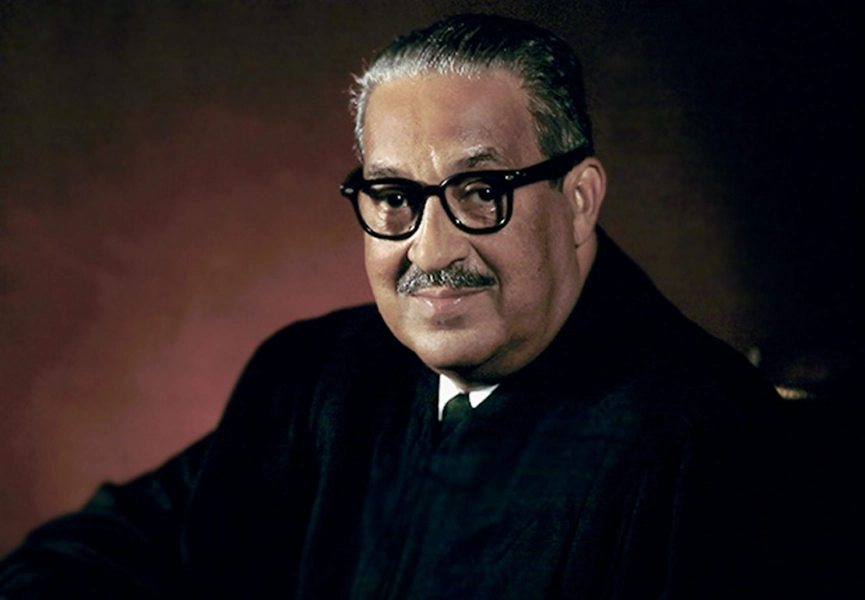Hampton Roads Community News
“Resistance”: In the Courts Thurgood Marshall, Civil Rights Attorney, Supreme Court Justice

By Jaelyn Scott
Winter Intern
New Journal and Guide
Thurgood Marshall was a prominent figure in the civil rights movement, having fought multiple court cases and winning most of them before he became the man that we know him for today. Being the first Black Associate Supreme Court Justice, Marshall paved the way for Black lawmakers everywhere, using his power and knowledge to help make bring justice to the American people. He served as a Supreme court justice for 24 years until he retired, being a judicial activist and leaving a mark on the community forever.
Marshall was born on July 2, 1908, to parents William, who was a railroad porter and steward at an all-white country club, and Norma Marshall, an elementary teacher. From an early age, William instilled an appreciation of the U.S. Constitution and the rule of law into young Thurgood, and he even took Thurgood with him to court cases sometimes to observe proceedings.
In his words, Marshall said that his father, “never told me to become a lawyer, but he turned me into one … He taught me how to argue, challenged my logic on every point, by making me prove every statement I made, even if we were discussing the weather.”
After graduating from high school in 1925, Marshall would go on to attend Lincoln University in Pennsylvania, graduating with honors and marrying his first wife, Vivian “Buster” Burey.
After graduating from Lincoln University, he went on to attend law school. He first tried to apply for the Maryland School of Law in Baltimore, but he was rejected because of his skin color, an event that he would carry with him throughout his career. He decided then to attend Howard university School of Law and was mentored by the school dean at the time, Charles Hamilton Houston. He graduated in 1933, graduating first in his class, and in that same year he would pass the Maryland Bar Exam and opened his own private law practice in Baltimore. During that time, he volunteered a lot at the Baltimore Branch of the NAACP.
His first successful case was two years later, in 1935, Murray v. Pearson, which was a suit that was brought against the University of Maryland on behalf of Douglas Gaines Murray, an African-American man, whose application for the Maryland school of law was rejected for the same reason Marshall was rejected: because of his race and skin color.
The case was successful, and a year later after that case, he followed Houston to New York, who had been appointed as the NAACP’s special counsel, where he worked as an assistant. It was here that they would work on another historical lawsuit, 1938s Missouri ex rel. Gaines v. Canada, another case where a Lloyd Lionel Gaines’ application to University of Missouri’s law school was rejected because of his race.
This would be the beginning of a long and ongoing attack on the racial segregation in schools and education, taking on and winning cases such as Chambers v. Florida in 1940, Sither v. Allright in 1944, Shelley v. Kraemer in 1948, Sweatt v. Painter and Mclaurin v. Oklahoma state reagents in 1950.
Finally, in 1954, he would make history and make a change in American Society, when he won Topeka’s Brown v. Board of Education, a suit that ruled that racial segregation in schools was unconstitutional. Sadly, also around this time he would lose his first wife, Vivian, to cancer in 1955, later marrying his second wife, Celica “Cissy” Suyat, and having two sons together.
In September 1961, John F. Kennedy appointed Marshall to the U.S. Court of Appeals for the Second Circuit, and 4 years later, Lyndon B. Johnson would name Marshall as the U.S. Solicitor General. Finally, in 1967, Marshall would be nominated by Johnson to become a Supreme Court Justice, and on August 30, 1967, he was officially confirmed for nomination, becoming the first African-American Supreme Court Justice.
He would proceed to serve in the Supreme Court until his eventual retirement, having served in a liberal court that slowly made a conservative shift over the years.
Marshall never wished to retire, saying, “I was appointed a life term, and I intend to serve it.” However, his health was slowly declining. Marshall would later pass away on January 24, 1993, in Bethesda, Maryland, two years after his retirement.














